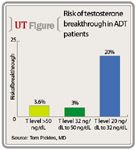Article
Testosterone breakthrough common in patients on androgen deprivation therapy
Among men treated with curative radiation therapy and neoadjuvant, adjuvant, or concurrent androgen deprivation therapy (ADT), about one-fourth fail to achieve or maintain true castrate levels of testosterone suppression.

"I recently reported at the 2011 congress of the European Association of Urology that testosterone breakthroughs during ADT are associated with worse PSA kinetics as an early measure of outcome. Therefore, as a take-home message, testosterone levels should be monitored whenever using ADT," said study co-author Tom Pickles, MD, professor of radiation oncology and developmental radiotherapeutics at the University of British Columbia, Vancouver.

The frequency of breakthroughs was calculated using three a priori defined levels of testosterone: ≥50 ng/dL, representing FDA criterion; ≥32 ng/dL, which is the level at which PSA fails to be suppressed; and ≥20 ng/dL, corresponding to the level achieved with orchiectomy.
Analysis of testosterone breakthrough rate per patient, which takes into account that the average patient received 5.5 injections over almost 1 year, showed a 3.6% risk of having at least one testosterone level above 50 ng/dL, a 3% risk of a testosterone level in the range of 32 ng/dL to 50 ng/dL, and a 20% risk of a testosterone level of 20 ng/dL to 32 ng/dL.
"These breakthrough rates are lower than have been reported in other series, and the difference probably relates to the assay used. When measuring testosterone, it is advisable to get input from the lab in interpreting the results because many assays are inaccurate in the castrate range," said Dr. Pickles, who presented the results at the AUA annual meeting in Washington.
Young, obese prone to breakthrough
Analyses of factors that predicted breakthrough using a logistic regression analytical model showed that men who were younger, obese, or who had a higher pretreatment testosterone level (>500 ng/dL) were most prone to breakthrough. Patient age had the strongest predictive value. LHRHa product used was not a significant predictor of breakthrough.
Dr. Pickles proposed that breakthroughs represent two different phenomena. He described the lower level breakthroughs as a physiologic effect that may be related to age, body mass index, and pretreatment testosterone. In addition, "device failure," in which testosterone level remains normal despite LHRHa treatment, occurs in a small, but not insignificant number of men.





